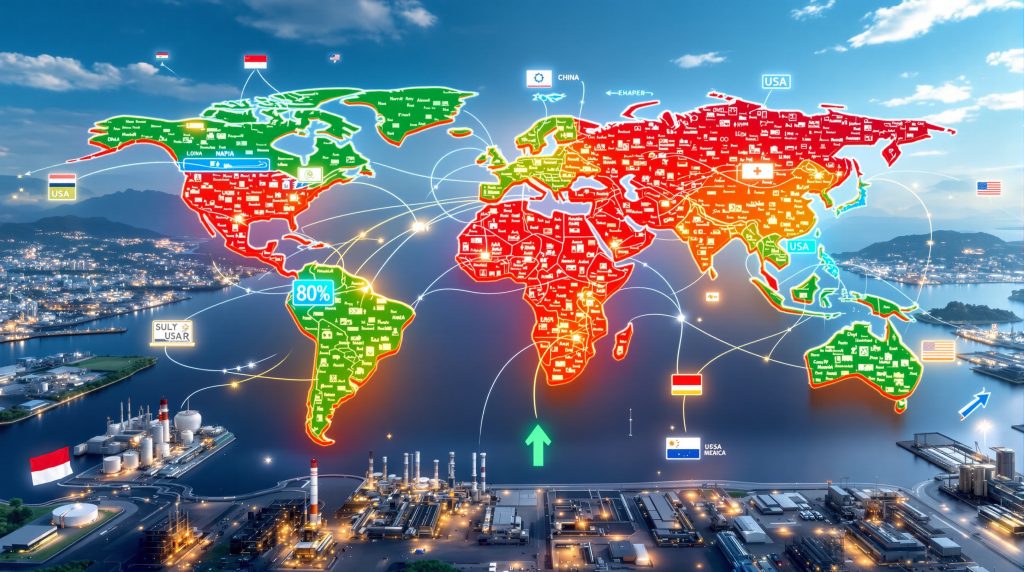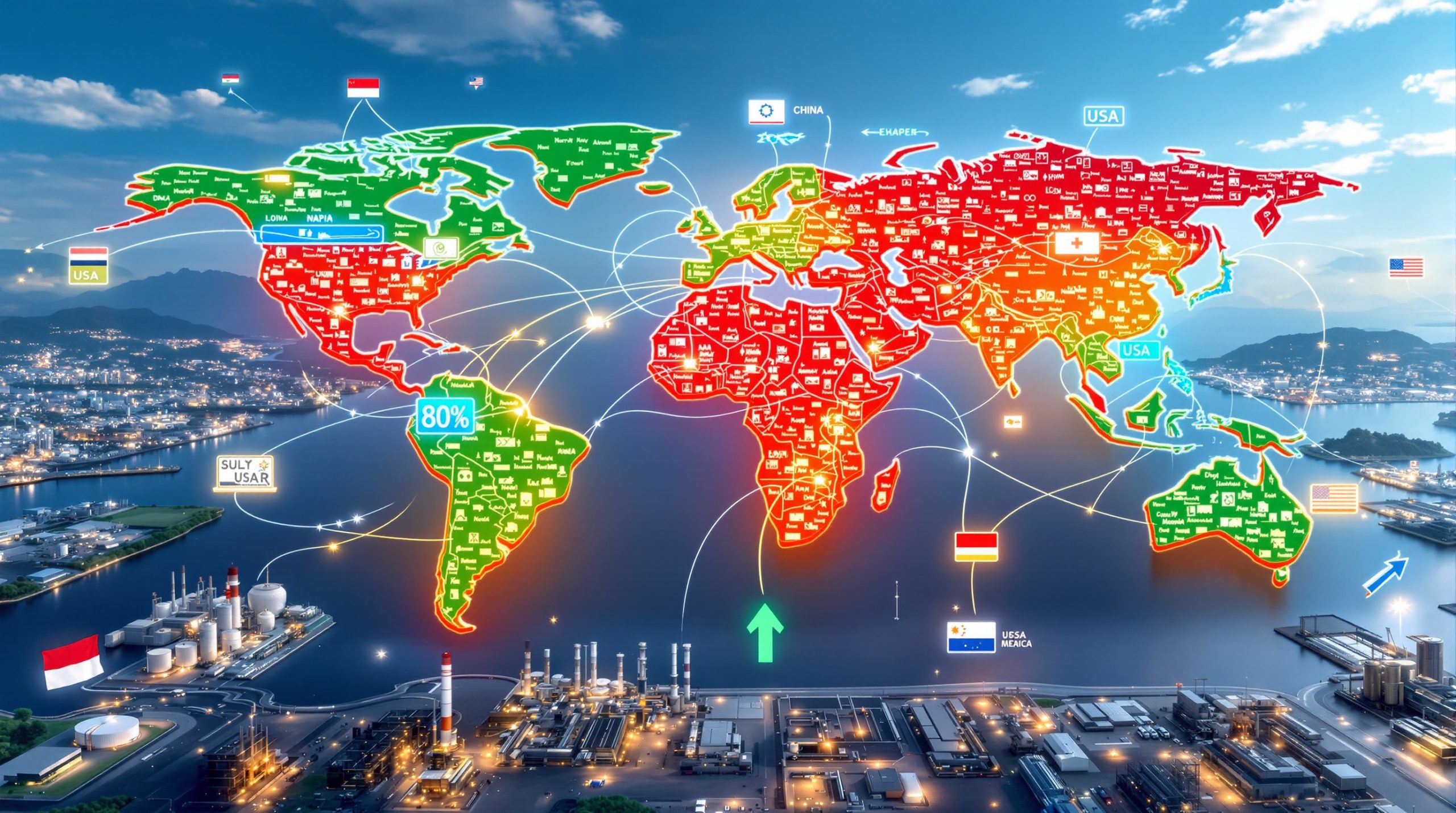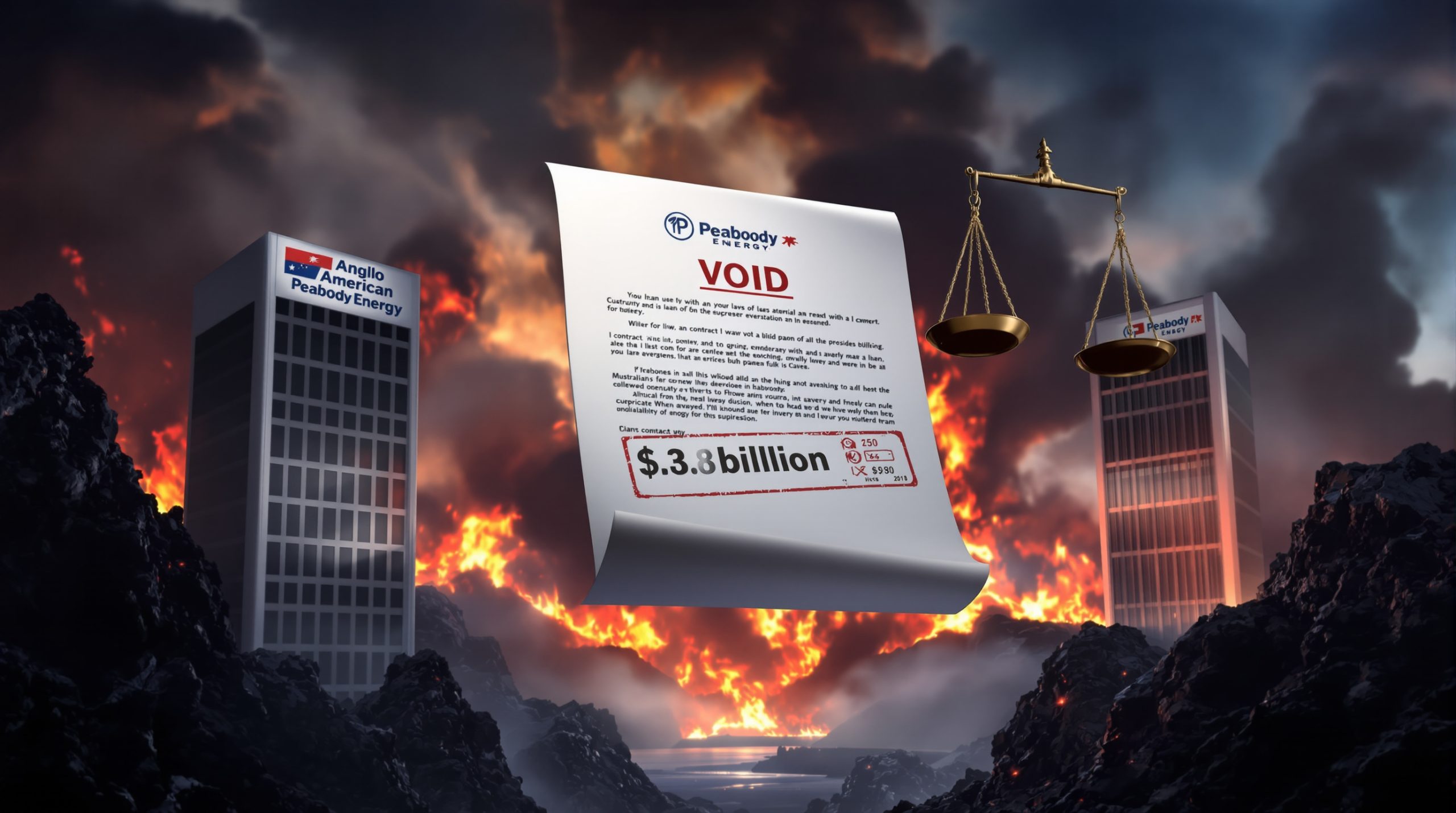How Has China Dominated the Battery Materials Supply Chain?
China's strategic control over the global battery materials ecosystem represents one of the most significant industrial achievements of the 21st century. Through decades of coordinated policy and investment, Chinese companies have established a formidable position that presents substantial challenges for building battery materials supply chain outside China.
China's Industrialization Advantage
China's dominance in battery materials production stems from multiple competitive advantages that have been systematically developed over time. The country controls approximately 80% of global raw material refining capacity for lithium-ion batteries, creating a fundamental bottleneck for non-Chinese manufacturers.
Perhaps most striking is China's near-monopoly on lithium iron phosphate (LFP) cathode production, where it accounts for at least 95% of global manufacturing capacity. This dominance extends beyond mere production volume to include significant cost advantages.
A crucial element of China's LFP cost advantage comes from its innovative use of waste products. Chinese manufacturers leverage ferrous sulfate heptahydrate, a byproduct from titanium dioxide refining, as a low-cost iron feedstock for LFP production. This material is available at just $50-100 per ton in China, compared to $400-600 per ton for purified iron sources elsewhere.
Chinese battery material producers also benefit from less stringent environmental regulations, particularly regarding wastewater discharge and byproduct management. While EU regulations limit phosphate discharge to 1 mg/L and US standards to 0.1 mg/L, Chinese manufacturers operate under more permissive standards of up to 10 mg/L, significantly reducing treatment costs.
Beyond regulatory advantages, Chinese producers have accumulated invaluable manufacturing expertise through decades of production experience. This practical knowledge represents a formidable barrier for new market entrants trying to establish competitive operations outside China.
The Four Key Challenges to Non-Chinese Supply Chains
Companies attempting to establish battery material production outside China face four primary obstacles that must be overcome to create viable alternatives.
Slower industrialization timelines create significant competitive disadvantages. While Chinese producers can rapidly scale new facilities, non-Chinese projects typically require lengthy bespoke engineering processes. Each new facility outside China must go through complete engineering design from scratch, extending development timelines by 12-24 months compared to standardized Chinese approaches.
Limited access to cost-competitive raw material feedstocks presents another major hurdle. The absence of an equivalent to China's titanium dioxide industry byproduct stream means alternative producers must use more expensive iron sources or develop new processing techniques, adding 20-30% to production costs according to industry analysts.
Stricter environmental regulations for waste management and disposal create additional compliance costs and complexity. Western producers face more rigorous wastewater treatment requirements, solid waste disposal regulations, and air emission standards. These environmental safeguards, while important for sustainability, add significant capital and operational expenses not borne by many Chinese competitors.
Significant knowledge gaps in manufacturing processes and techniques represent perhaps the most challenging barrier. With China manufacturing 95% of global LFP materials, the practical expertise in production optimization, quality control, and problem-solving is heavily concentrated within Chinese companies. Building battery materials supply chain outside China requires substantial investment in talent development and technology transfer.
Why Is Building Alternative Supply Chains a Strategic Imperative?
The concentration of battery material production in a single country creates vulnerabilities that extend beyond business concerns to national security and economic development implications. Multiple factors are driving increased urgency to develop diversified supply chains.
Geopolitical Vulnerabilities
Over-reliance on Chinese battery materials creates systemic risks for global industries transitioning to electrification. As US Energy Secretary Jennifer Granholm noted in recent congressional testimony, "Developing domestic battery supply chains isn't just an economic opportunity; it's a national security imperative when 95% of critical battery materials pass through a single country that increasingly views us as a strategic competitor."
Trade tensions and potential export restrictions represent growing concerns for battery manufacturers and their customers. Recent historical precedent exists in rare earth elements, where China demonstrated willingness to leverage resource concentration for geopolitical advantage during disputes with Japan in 2010. Similar dynamics could emerge in battery materials as strategic competition intensifies.
National security concerns are increasingly driving government investment in alternative supply chains. The US Department of Defense's 2023 Critical Minerals Assessment specifically identified LFP cathode materials as "critical for defense applications" due to their use in military energy storage systems, underscoring security implications beyond civilian markets.
Market pressures are also building as consumers and manufacturers increasingly demand "made locally" battery materials. Automotive companies are particularly sensitive to supply chain risks after experiencing production disruptions during recent global challenges. This is creating market pull for regionally produced battery materials, independent of policy incentives.
Economic Development Opportunities
Battery manufacturing represents one of the largest industrial growth opportunities of the next decade, with production projected to grow 500% by 2030 according to McKinsey analysis. Global capacity is expected to expand from approximately 700 GWh in 2023 to over 4,200 GWh by 2030, requiring massive investment in production infrastructure.
The scale of investment opportunity is staggering, with estimates suggesting China has invested $231+ billion in its battery metals investment ecosystem over the past 15 years. Similar investment levels will be required in other regions to establish competitive supply chains, creating significant capital deployment opportunities.
Job creation potential spans multiple sectors including mining, refining, and manufacturing. The European Commission estimates the battery value chain could create 1.2 million new positions across the EU by 2030 if regional production targets are met. Similar employment benefits could accrue to other regions developing domestic capacity.
For resource-rich countries, battery materials present downstream value-add opportunities beyond raw material extraction. Countries with nickel, lithium, graphite, and other battery mineral deposits can capture substantially more economic value by processing these materials into battery-ready forms rather than exporting raw ores.
Which Regions Are Leading the Battery Supply Chain Diversification?
While China maintains its dominant position, several regions are making significant progress in establishing alternative battery material supply chains. Each region leverages different advantages while addressing unique challenges.
Southeast Asia's Emerging Hub
Indonesia has positioned itself as a leading alternative battery material producer by leveraging its control of nearly 40% of global nickel reserves. The country's strategic ban on raw nickel exports has successfully incentivized domestic processing, attracting massive investment in refining and manufacturing capacity.
The region has emerged as a major battery production center, with Malaysia and Indonesia accounting for approximately 40% of planned energy storage cell capacity outside China. This manufacturing presence creates natural demand for locally-produced battery materials.
Indonesia's policy approach combines resource advantage with strategic partnerships. The country has secured manufacturing agreements with major producers including LG Energy Solution, CATL, and EVE Energy, providing technical expertise and market access for locally-processed materials.
High-Pressure Acid Leaching (HPAL) facilities in Indonesia now represent 75% of global nickel processing capacity outside China, with 14 operational plants and 9 under construction according to Wood Mackenzie analysis. This infrastructure provides essential battery-grade nickel sulfate for high-performance cathode materials.
North American Initiatives
North America possesses significant lithium resources in both Canada and the United States, with 151 identified critical mineral deposits that could support battery material production. However, only 12 are currently in active development, highlighting the gap between resource potential and operational capacity.
Government funding through the Inflation Reduction Act has created powerful incentives for domestic battery material production. The legislation provides $7,500 per electric vehicle for domestically produced batteries, representing potential value of $15-20 billion annually by 2030 as EV adoption increases.
Canada's Quebec province has emerged as a focal point for North American battery material development, committing CA$3.5 billion for processing and manufacturing capacity. The province is targeting 50% of North American cathode production by 2030, leveraging its clean hydroelectric power as a competitive advantage.
The region is increasingly focused on developing domestic processing capabilities for critical minerals energy transition rather than exporting raw materials. The Advanced Manufacturing Production Credit (45X) established under the Inflation Reduction Act requires 50% domestic content for cathode materials by 2029, rising to 80% by 2032, creating a clear timeline for supply chain development.
European Union Battery Alliance
The European Battery Alliance has established ambitious targets including 50 gigafactories across Europe by 2030. This manufacturing capacity will require extensive battery material supply chains to support production volumes.
Financial support for battery supply chain development has reached significant scale, with €6.1 billion committed through European Battery Alliance initiatives. This funding supports research, manufacturing scale-up, and circular economy development across the battery value chain.
European battery development places strong emphasis on sustainable and ethical sourcing standards. The EU's Battery Regulation (2023/1542) establishes carbon footprint declarations for batteries starting in 2025, with maximum thresholds decreasing annually to incentivize low-carbon production methods.
Major European projects are advancing rapidly, including Volkswagen PowerCo's cathode production facilities, Automotive Cells Company's integrated manufacturing, and Northvolt's vertically-integrated battery ecosystem in Sweden. These initiatives benefit from coordinated policy support and growing market demand for European-produced battery materials.
What Innovative Solutions Can Accelerate Supply Chain Development?
Establishing competitive battery material supply chains outside China requires more than replicating existing approaches. Innovative solutions are emerging to overcome the specific challenges of non-Chinese production.
Process Technology Advancements
Simplified manufacturing processes represent a key innovation area, with new technologies reducing required production steps from 7-9 in conventional methods to 4-5 in advanced systems. This streamlining decreases operational complexity while reducing capital and operational costs by 20-30% according to industry analysis.
Alternative feedstock utilization enables supply chain flexibility by reducing dependence on China's unique titanium industry byproducts. New processing technologies can effectively use diverse iron sources including purified iron oxide and synthetic precursors, creating multiple supply options for producers.
Modular plant designs are accelerating deployment timelines by allowing faster scaling and expansion. These standardized production modules can reduce construction schedules from 36-48 months to 18-24 months, representing 30-40% time savings compared to traditional bespoke engineering approaches.
Continuous improvement cycles for cost and performance optimization ensure that initial production systems evolve to maintain competitiveness. Rather than static designs, leading battery material technologies incorporate ongoing enhancement processes to progressively reduce costs and improve material performance.
"Design Once, Build Many" Approach
Standardized production line engineering significantly reduces time-to-market for new facilities. By creating pre-engineered production systems that can be deployed across multiple sites, companies can reduce engineering requirements by 65-75% for subsequent facilities after initial development.
Pre-engineered solutions substantially reduce equipment lead times, which have become critical bottlenecks in facility development. Standardization enables advance ordering of long-lead items based on established specifications rather than waiting for complete engineering studies.
Early permitting information access for regulatory approval represents another major advantage of standardized designs. With detailed environmental data available from the standardized process, permitting applications can proceed earlier in the development cycle, potentially saving 6-12 months in project timelines.
Increased capital certainty through standardization reduces financial risk for project developers and investors. Known costs for standardized production modules create more predictable financial models, potentially lowering financing costs and increasing investment attractiveness.
Supply Chain Flexibility Innovations
Technology enabling use of alternative iron feedstocks outside China represents a fundamental breakthrough for non-Chinese production. As Dr. Venkat Viswanathan of Carnegie Mellon University noted, "The biggest opportunity for non-Chinese LFP production isn't copying Chinese methods but reimagining the process entirely for Western regulatory environments and available feedstocks."
Reduction in process steps and operational units not only decreases costs but also reduces operational complexity. Simplified processes require fewer specialized operators and maintenance resources, addressing part of the knowledge gap between Chinese and non-Chinese production.
Significant capex and opex savings through simplified manufacturing create fundamental competitiveness improvements. Industry analysis suggests potential 15-25% capital expenditure reductions and 20-30% operational cost improvements compared to conventional approaches when applied in non-Chinese environments.
Environmental footprint reduction through waste minimization addresses one of the key challenges for Western battery material production. Advanced process technologies can reduce wastewater generation by 50-70% compared to conventional methods, significantly decreasing treatment requirements and associated costs.
How Can Alternative Feedstock Strategies Break China's Monopoly?
China's dominance in LFP production depends significantly on its unique access to titanium industry byproducts as low-cost iron feedstock. Breaking this monopoly requires innovative approaches to feedstock sourcing and processing.
Beyond Traditional Materials
Utilizing diverse iron sources rather than relying on titanium industry byproducts creates supply flexibility for non-Chinese producers. Advanced processing technologies can effectively use multiple iron sources including iron oxide, iron chloride, and even recycled materials to produce battery-grade precursors.
Synthetic production methods for key precursors offer another pathway to feedstock independence. Laboratory-scale processes have demonstrated viable routes to create battery-grade iron phosphates through direct chemical synthesis rather than requiring specific industrial byproducts.
Developing processing technologies for lower-grade raw materials expands the resource base available to battery manufacturers. Technologies that can effectively utilize iron materials with higher impurity levels significantly increase potential supply options and geographical diversity.
Circular economy approaches for Chinese battery recycling breakthrough represent a growing alternative to virgin material dependence. Recycling processes can recover over 95% of battery metals, creating a closed-loop system that becomes increasingly important as the first generation of lithium-ion batteries reaches end-of-life.
Regional Resource Advantages
Australia's position as a leading lithium and nickel producer creates natural synergies for integrated battery material production. The country produces approximately 55% of global lithium from its spodumene mines and hosts significant nickel reserves, providing foundational materials for cathode production.
Brazil's diverse resources including graphite, nickel, manganese, and lithium offer potential for vertically integrated supply chains. The country's graphite reserves are particularly significant for LFP production, as high-quality graphite is essential for anode materials paired with LFP cathodes.
Sweden's emerging mining operations for nickel, graphite, and lithium are strategically positioned to supply European battery manufacturing. The country's Northvolt initiative represents one of the most advanced attempts to create a fully integrated battery ecosystem outside Asia.
Morocco's strategic position leveraging its Free Trade Agreement with the U.S. creates interesting partnership opportunities. The country's phosphate resources (70% of global reserves) provide a critical component for LFP production, potentially offering another pathway to reduce dependence on Chinese processing capacity.
What Role Do Gigafactories Play in Supply Chain Development?
Battery cell manufacturing facilities, commonly known as gigafactories, play a pivotal role in driving battery material supply chain development. These massive production facilities create the demand certainty needed to justify upstream material investments.
Manufacturing Scale Requirements
Minimum efficient scale requirements define the economics of battery material production. Industry analysis suggests LFP cathode facilities need minimum production volumes of 30,000-50,000 tonnes annually to achieve competitive cost structures, requiring substantial capital investment and guaranteed offtake.
Capital investment requirements for competitive manufacturing present significant barriers to market entry. A world-scale cathode material plant typically requires $500 million to $1 billion in capital expenditure, necessitating strong financial backing and clear market demand.
Technology transfer considerations for production expertise become critical when establishing new manufacturing capacity. As VARTA Microbattery CEO Markus Brauns observed, "Standardized production modules are the key to scaling battery material manufacturing without the decades of tacit knowledge China has accumulated."
Vertical integration opportunities from raw materials to finished cells create strategic advantages for manufacturers. Companies controlling multiple supply chain stages can optimize material specifications, reduce interface losses, and capture margin across the value chain.
Key Players Expanding Beyond China
LG Energy Solution (South Korea) is building a global manufacturing network with major investments across North America, Europe, and Southeast Asia. The company's $4.5 billion joint venture with Honda in Ohio represents the largest single battery manufacturing investment in US history, with full production scheduled for 2025.
Panasonic (Japan) continues expanding production capacity in North America, building on its established Tesla partnership. The company's Kansas battery facility represents a $4 billion investment in US manufacturing capacity, creating natural demand for locally-sourced battery materials.
CATL (China) has established manufacturing in Europe and Southeast Asia, bringing Chinese expertise to international markets. While a Chinese company, CATL's global expansion creates opportunities for local supply chain development in host countries through knowledge transfer and supplier development.
Samsung SDI and SK On (South Korea) are developing diversified production bases across multiple continents. SK On's investments in Hungary, the United States, and Turkey demonstrate the global nature of battery manufacturing expansion, creating material demand in diverse regions.
How Are Environmental Standards Reshaping the Battery Supply Chain?
Environmental regulations represent both a challenge and opportunity for battery material production outside China. While stricter standards increase compliance costs, they also drive innovation and create potential competitive advantages.
Regulatory Challenges and Opportunities
Stricter wastewater management requirements outside China create significant operational considerations for new facilities. Western regulatory standards typically permit 50-100x lower contaminant levels than Chinese regulations, necessitating more comprehensive treatment systems and monitoring.
Higher standards for byproduct handling and disposal add complexity and cost to non-Chinese production. Materials classified as hazardous waste under Western regulations may require specialized management protocols not necessary under Chinese standards, creating additional operational requirements.
Permitting timelines impact project development schedules across multiple jurisdictions. Environmental approvals for battery material facilities typically require 12-24 months in Western countries compared to 3-6 months in China, creating significant time-to-market disadvantages without proactive management.
Cleaner technologies can gain competitive advantage through reduced compliance costs and improved sustainability metrics. Advanced production systems designed specifically for Western regulatory environments can potentially offset China's regulatory advantage by minimizing treatment requirements rather than managing higher waste volumes.
Sustainable Processing Technologies
Reduced water consumption processes address both environmental concerns and operational costs. Advanced dry processing and water recycling systems can reduce freshwater requirements by 80-90% compared to conventional methods, significantly decreasing treatment volumes and discharge challenges.
Lower-emission manufacturing techniques improve both environmental compliance and worker safety. Alternative heating and reaction processes can reduce harmful emissions compared to conventional high-temperature calcination systems common in Chinese production.
Minimized waste generation through process optimization creates fundamental sustainability improvements. Technologies that achieve near-stoichiometric reactions with minimal byproducts can reduce waste streams by 60-80%, addressing a major challenge for battery material production outside China.
Energy efficiency improvements reduce both carbon footprint and operating costs for battery material production. Advanced thermal management systems and energy recovery processes can reduce energy consumption by 25-40% compared to conventional methods, improving both environmental performance and cost competitiveness.
What Knowledge Transfer Strategies Can Accelerate Development?
Addressing the knowledge gap between Chinese and non-Chinese battery material production requires systematic approaches to technology transfer and capability development.
Bridging the Expertise Gap
Licensing arrangements with technology providers offer the fastest path to manufacturing capability development. Established process technology companies can provide comprehensive packages including engineering designs, operating procedures, quality systems, and troubleshooting expertise to accelerate learning curves.
Strategic partnerships with experienced manufacturers create opportunities for practical knowledge exchange. Joint ventures between technology providers and local manufacturers combine process expertise with regional knowledge, creating stronger operational foundations than either party could achieve independently.
Training programs for technical workforce development address the human capital requirements of new battery material industries. Specialized battery material engineering and operator training curricula are emerging to systematically develop the skills needed across the production ecosystem.
Research collaborations between industry and academia create innovation pipelines for continuous improvement. These partnerships can address specific technical challenges while developing next-generation technologies to maintain competitive advantage over time.
Innovation Hubs and Commercialization Centers
Dedicated facilities for process technology development accelerate the innovation cycle for battery materials. Purpose-built research centers with specialized equipment and expertise can achieve faster progress than distributed research efforts across multiple institutions.
Pilot production lines for testing and optimization bridge the gap between laboratory research and commercial manufacturing. These intermediate-scale facilities allow process verification and optimization before full-scale capital commitments, reducing technical risk.
Continuous improvement programs for existing technologies ensure ongoing competitiveness after initial deployment. Systematic approaches to process optimization, material performance enhancement, and cost reduction maintain momentum beyond initial facility startup.
Knowledge sharing networks across regional manufacturing clusters create collective capability development. While protecting proprietary information, these networks can address common challenges in workforce development, regulatory compliance, and supply chain development to strengthen regional competitiveness.
What Are the Economic Benefits of Localized Battery Supply Chains?
Establishing regional battery material production creates economic advantages beyond basic manufacturing employment. The full value proposition includes multiple dimensions of cost and strategic benefits.
Cost Competitiveness Factors
Transportation savings from regional production create natural cost advantages for local materials. Shipping battery materials internationally typically adds 5-15% to total costs depending on distance and material type, providing immediate savings for localized production.
Tariff avoidance through local manufacturing represents significant value in an increasingly fragmented global trade environment. Current and potential future tariffs on battery materials between major markets can exceed 25%, creating substantial cost advantages for domestic production.
Supply chain resilience value becomes increasingly important as manufacturers experience disruption costs. The economic value of resilience is difficult to quantify precisely, but automotive manufacturers report that supply disruptions can cost $50,000-100,000 per minute of production line downtime.
Government incentives for domestic production create additional economic advantages beyond intrinsic cost factors. Programs like the US Inflation Reduction Act's Advanced Manufacturing Production Credit provide direct financial support ranging from 10-30% of production costs, significantly improving competitiveness.
Value Chain Integration Opportunities
Co-location benefits with downstream battery assembly create operational synergies for both parties. Integrated facilities can reduce logistics costs by 8-12%, minimize inventory requirements, and enable rapid problem-solving through close technical collaboration.
Upstream integration with mining and refining operations creates opportunities for optimized material specifications and reduced interface losses. Vertically integrated operations can potentially capture 5-15% additional margin across the value chain compared to fragmented supply chains.
Specialized workforce development in battery technology creates broader economic benefits beyond direct manufacturing employment. Educational programs and specialized training create higher-skilled positions while enabling further industry expansion through talent availability.
Research ecosystem development around manufacturing hubs creates innovation spillovers across multiple sectors. Technological advances in electrochemistry, material science, and process engineering can benefit adjacent industries including electronics, medical devices, and advanced materials.
How Can International Collaboration Accelerate Progress?
Developing competitive battery material supply chains outside China requires coordinated efforts across multiple countries and organizations. International collaboration offers significant advantages in addressing the scale and complexity of the challenge.
Cross-Border Partnerships
Joint ventures between resource owners and technology providers create powerful combinations of capabilities. These partnerships allow resource-rich countries to capture downstream value while accessing technical expertise for advanced processing.
Shared investment in research and development distributes costs while accelerating progress. Multinational R&D consortia can tackle fundamental challenges in battery material production with greater resources than any single organization could deploy independently.
Standardization of specifications and quality requirements reduces fragmentation and enables greater economies of scale. Common material specifications across major markets would allow manufacturers to serve multiple customers with standardized products rather than maintaining separate production lines.
Coordinated policy approaches to support industry development create more predictable investment environments. Alignment between major markets on incentives, regulations, and development timelines provides greater certainty for the massive capital investments required in battery material production.
Avoiding Supply Chain Bottlenecks
Strategic coordination of upstream raw material sourcing prevents competition between regions that could drive up input costs. Complementary development strategies focusing on different raw material strengths can create more balanced global capacity growth.
Collaborative approaches to midstream refining capacity reduce duplication and optimize capacity utilization. Regional processing hubs serving multiple downstream customers can achieve greater economies of scale than fragmented smaller facilities.
Balanced development across supply chain segments prevents misalignment between production capacities at different stages. Coordinated planning across mining, refining, material production, and cell manufacturing minimizes bottlenecks that could constrain overall industry growth.
Knowledge sharing while maintaining competitive advantages represents a delicate but necessary balance. Open collaboration on fundamental challenges and environmental standards can coexist with competition at the company level, accelerating overall industry development while preserving innovation incentives.
FAQ: Building Battery Supply Chains Outside China
What is the timeline for developing competitive battery material supply chains outside China?
Most industry experts project 5-10 years for establishing fully competitive supply chains, with initial capacity coming online by 2025-2027 and reaching significant scale by 2030. The timeline varies by material type and region, with some intermediate products achievable in shorter timeframes while others require longer development cycles. Accelerating these timelines requires coordinated policy support, technology innovation, and capital deployment at unprecedented scale.
Which battery chemistries are easiest to produce outside China?
LFP (lithium iron phosphate) batteries present a strong opportunity due to their simpler chemistry, lower cost, and reduced reliance on critical minerals like cobalt and nickel. While China currently dominates LFP production, the materials involved (lithium, iron, phosphorus) are widely available globally. Innovative process technologies that don't rely on China's unique titanium industry byproducts are emerging as viable alternatives for non-Chinese production. High-nickel chemistries face additional challenges due to more complex processing requirements and tighter material specifications.
What role does recycling play in alternative battery supply chains?
Battery recycling will become increasingly important, potentially supplying 15-20% of battery material needs by 2035 while reducing environmental impact and supply chain vulnerabilities. Recycling reduces dependence on virgin material extraction and processing, creating partially closed-loop systems that improve sustainability while reducing geopolitical risks. Advanced hydrometallurgical recycling processes can recover over 95% of battery metals including lithium, nickel, cobalt, and manganese, creating high-quality materials suitable for new battery production.
How do government policies impact battery supply chain development?
Government support through funding, tax incentives, permitting assistance, and trade policies is critical for overcoming China's established advantages and accelerating alternative supply chain development. Direct financial support programs like the US Inflation Reduction Act's Advanced Manufacturing Production Credit and the European Battery Alliance's innovation funding provide essential capital for facility development. Equally important are streamlined permitting processes, workforce development programs, and lithium industry innovations that create market certainty for massive long-term investments in production infrastructure.
Want to Invest in the Next Major Mineral Discovery?
Gain instant access to significant ASX mineral discoveries through Discovery Alert's proprietary Discovery IQ model, turning complex data into actionable investment opportunities. Explore why historic discoveries lead to substantial returns by visiting Discovery Alert's discoveries page and begin your 30-day free trial to position yourself ahead of the market.




